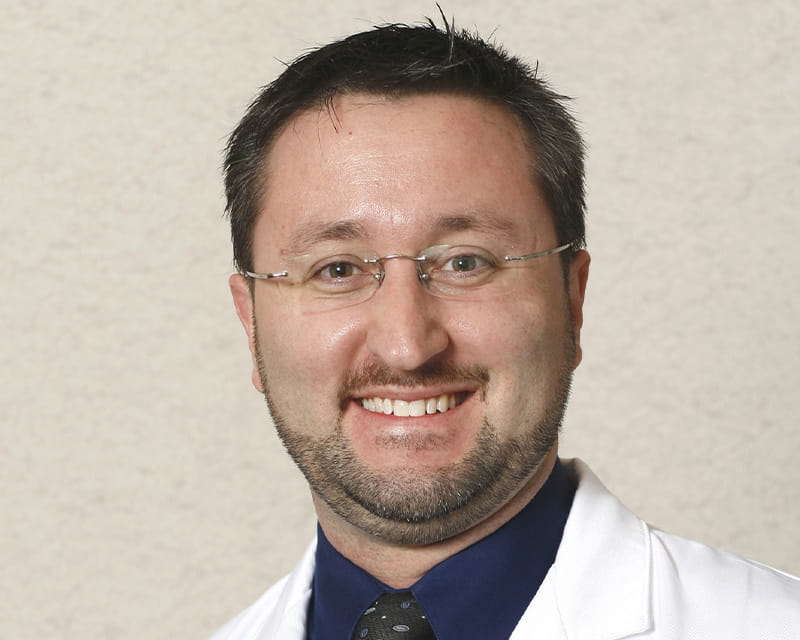
Robotic-assisted surgery with intraoperative radiation offers new hope to patients with local cancer recurrence
 Michael Gong, MD, PhD, is developing a patient-centered program to improve perioperative education for those undergoing radical prostatectomy and cystectomy. Dr. Gong is a urologic oncologist and prostate cancer specialist at The Ohio State University Wexner Medical Center.
Michael Gong, MD, PhD, is developing a patient-centered program to improve perioperative education for those undergoing radical prostatectomy and cystectomy. Dr. Gong is a urologic oncologist and prostate cancer specialist at The Ohio State University Wexner Medical Center.
Patients scheduled for complex pelvic surgery have anxiety and questions regarding their surgery and postoperative recovery. Often, these concerns are addressed during a single office visit. Programs that offer onsite preoperative education sessions have been shown to decrease patient anxiety and improve compliance. However, if patients can’t or don’t attend, they miss important information that could help them avoid postoperative complications and have a better quality of life before and after surgery.
The difficulties of traveling to an education site, particularly if they must take time off work to do so, can be especially burdensome on patients covered by Medicaid. Research shows that Medicaid patients undergoing radical prostatectomy have increased morbidity and mortality and decreased quality of life due to issues with urinary incontinence and sexual function. Venous thromboembolic events and hospital readmission rates after complex cancer surgery, including radical cystectomy, are also higher in Medicaid patients. These challenges can be costly for patients and health care entities alike.
“The unique part of our Prostatectomy Preparedness Program is that it will be video-based,” Dr. Gong says. “And it will be offered through the patient’s medical record.”
The program is funded by a Patient Care Innovation grant from Ohio State University Physicians, Inc., and was developed in conjunction with Claire Postl, MA, LPCC, a psychotherapist within Ohio State’s Department of Urology who’s been instrumental in the department’s patient education efforts. Initially focused on patients undergoing radical prostatectomy, it includes a series of videos created to educate patients about how to prepare for, and what to expect from, their upcoming surgery, as well as how to decrease their risk for complications. They’ll also receive questionnaires that evaluate recovery of continence and erectile function after surgery.
“If we see someone who’s not improving, that will be a trigger for us to reach out to the patient and get him a little more in-person help or at least have a discussion about how we can help him advance,” Dr. Gong says.
Upon enrollment in the program, which is offered to anyone with nonmetastatic prostate cancer, patients can access the videos through Epic’s MyChart Care Companion app on their phone, tablet or computer at their convenience.
“Our hope is that the videos will allow patients to get their education early,” Dr. Gong says. “They can watch the videos at any time and as many times as they want.”
Surgeon introduction videos that explain the rationale of the education program and a video on prostate anatomy and the prostatectomy procedure will be offered first. Additional videos will address:
Enrolled patients receive a schedule of videos to watch and tasks to complete via the MyChart Care Companion app.
In late 2023, the team will expand education efforts.
“We hope we’ll learn something from the Prostatectomy Preparedness Program,” Dr. Gong says. “As we do, we’ll fine-tune the cystectomy program. It’s a much more complicated process.”
Though many of the cystectomy videos will have content similar to the Prostatectomy Preparedness Program, there will be differences. For example, because male and female cystectomy patients often lose muscle mass and weight during their long recovery, their physical therapy video will offer tips on lowering this risk. The dietary video will also provide strategies for gaining or maintaining weight pre- and post-surgery.
In separate videos, a wound care nurse will provide information about different types of urinary diversion and their maintenance, including the Indiana pouch, ileal neobladder and ileal conduit. The nurse will offer overviews of different catheter types and show patients how to use them, as well.
With early education and initiation of pelvic floor physical therapy, for instance, some evidence suggests male patients undergoing prostatectomy may have better postoperative continence. Immediate postoperative penile therapy may increase erectile function, as well. And having the right information may help patients take the steps necessary to reduce thromboembolic events.
The benefits of all of this to patients can be significant. But health care providers may reap rewards, too. It’s hoped the program will reduce the need for in-person visits and phone calls to providers. And with decreased complication rates and hospital readmissions, there may also be substantial cost savings.
Overall, these efforts are intended to bolster patient understanding of their disease and participation in their health care, better address patient anxiety and depression and increase patient compliance. This, in turn, can increase postoperative quality of life and outcomes for patients, especially those disadvantaged by health care disparities.
The first patients are expected to enroll in the Prostatectomy Preparedness Program in late 2022.